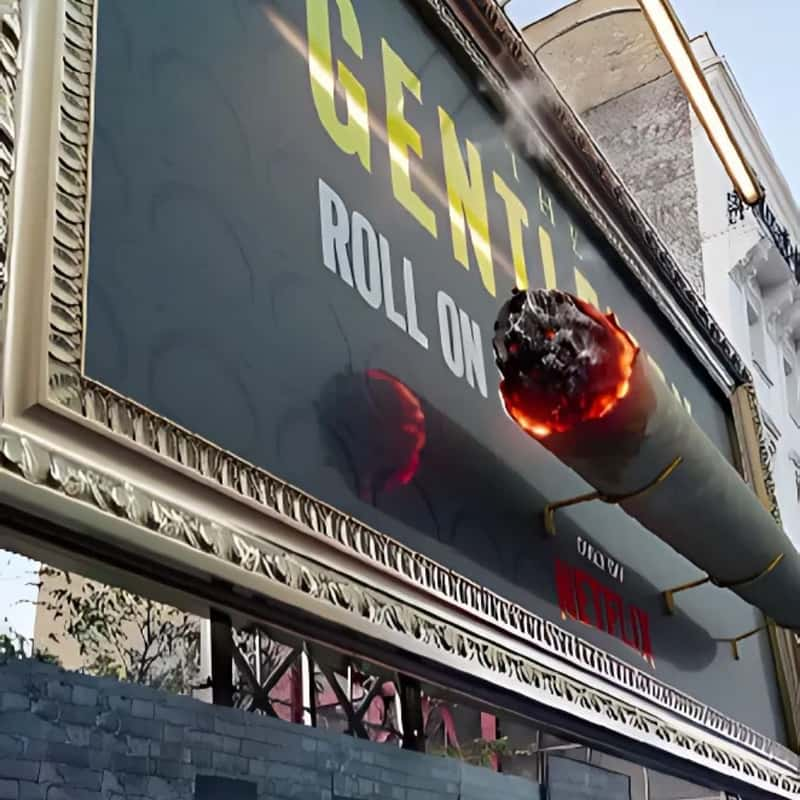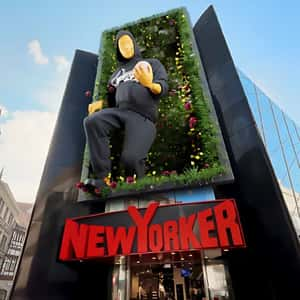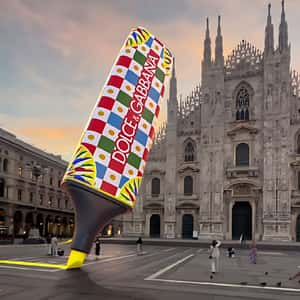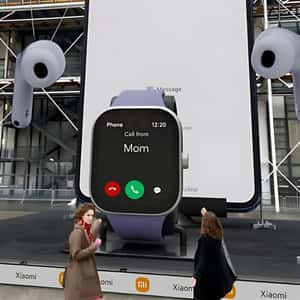How FOOH is Changing Movie Marketing – Lessons from Viral Campaigns
Is this the new way to promote movies? Here is all you need to know about FOOH movie marketing.

It’s Oscar week, which means all eyes are on the film industry. Amid the red carpet, speeches, and box office talk, we must also highlight a key factor in a movie’s success: marketing.
In a time of short attention spans and tough competition, traditional marketing needs a boost. That’s why studios are turning to a bold new approach: Fake Out-of-Home (FOOH) advertising.
To read more about what FOOH Ads are and how they work check out our 2025 Beginner’s Guide for Agencies.
For movie marketers and agencies alike, this shift represents a huge opportunity. Not just to promote films and TV series, but to craft cultural moments that audiences actively engage with.
The question isn’t how to advertise a movie but how to turn it into an experience that people will remember, talk about, and share. Let’s break down why FOOH is changing the game and how marketers can harness its power.
The 3 Key Reasons That Make FOOH a Game Changer for Movie Advertising (and Beyond)
A seismic shift is occurring in how marketers are promoting movies. Trailers, interviews, and TV spots are still useful, but they often fall short. In a world where content is everywhere, these methods alone can’t grab audience attention.
The advertising world is shifting to immersive, dynamic, and interactive formats. The numbers show this change. Out-of-home cinema advertising grew by 41% in the first quarter of 2024 compared to last year. This shows a rising demand for active campaigns that engage viewers. 1
This turn highlights a crucial trend: audiences no longer want to see ads—they want to experience them. And that’s exactly where FOOH comes into the picture. By blurring the line between reality and fiction, FOOH creates high-impact, shareable moments that draw people in, making movie marketing not just seen but felt.
1. It Creates Cultural Moments
We all remember the huge marketing push for Barbie The Movie in 2023. When the marketing campaign launched, it didn’t just promote a movie. It turned the (social media) world pink.
Airbnb listed a real-life Barbie Dreamhouse; pink billboards took over cities worldwide. This wasn’t just movie marketing; it was a global pop culture moment.
A key factor in this takeover? FOOH ads. From a massive CGI Barbie breaking out of its box to a bubbly Zara FOOH Ad promoting its Barbie collection, these campaigns transformed everyday spaces into surprising brand moments.
2. It Transports Fiction into Reality
A well-executed FOOH campaign makes people question what’s real and what’s not. When people walk through a city and spot CGI elements blended with the scenery, it grabs their attention and boosts engagement.
3. It Drives Social Media Virality
The best FOOH campaigns don’t rely on paid media – they’re designed to be shared. When the campaign is effective, people will take screenshots, chat about it on TikTok, and share it in their conversations. This will boost the message on its own. That’s free marketing at an unmatched scale.
For agencies, the lesson here is clear: Don’t just advertise a movie; turn it into an experience.
3 Examples of Viral TV Shows & Movie FOOH Campaigns
These films didn’t just market – they immersed audiences before the first scene even hit the screen. Here’s what we can learn from them:
1. Lilo & Stitch Super Bowl Promo
Now this FOOH Ad proved how the right occasion with the right story can really make an ad go viral. In the Super Bowl 2025, an ad staged a fake tech glitch. Stitch crashed the broadcast, creating chaos on the football field. This clever execution not only entertained but also ensured the ad stayed in conversation long after the game.
The numbers speak for themselves. It got 14 million views, over 650,000 likes, and 205,000 shares. It became one of the most talked-about ads of the game, proving just how powerful the right execution can be.
2. House of the Dragon
For the House of the Dragon season 2 premiere, an ambitious FOOH campaign took over major cities worldwide. From New York to Johannesburg, clips flooded social media. Banners rolled down buildings, urging viewers to choose a side. This creative execution created anticipation and a sense of curiosity even for people who hadn’t seen the show, making it an effective and immersive promotional experience.
3. Gladiator II
For the 2024 Gladiator sequel, various FOOH ads changed locations worldwide into immersive experiences. These spots evoked the spirit of Ancient Rome. A gladiator ship floated down the Seine in Paris. Meanwhile, a subway stop in Rome had a huge gladiator helmet graphic on a door.
The most striking execution, however, turned the Cinéma Pathé Plan de Campagne in France into a Roman Colosseum. The theater’s outside was digitally changed to look like an ancient battleground. And this made people feel like they were stepping back in time.
5 Key Strategies for Movie Marketers
Agencies should not only pick the right format but also think creatively. They need to explore how FOOH can make the biggest impact. Here are 5 key strategies to ensure your FOOH campaign stands out:
1. Prioritize Storytelling
A visually stunning FOOH campaign is great, but it also needs to serve a narrative purpose. When audiences see a fake out-of-home stunt, they should immediately connect it to the world of the film.
One way to do this is by involving movie characters. For famous franchises, using recognizable symbols, logos, or visual motifs can also connect with fans. For example, a Spider-Man campaign might use spiderwebs spanning across buildings. While, a Harry Potter FOOH ad could feature a floating Elder Wand casting spells in the real world.
A Fast & Furious stunt isn’t complete without speedy muscle cars. Similarly, Game of Thrones hooks viewers with dragons gliding over cities.
By anchoring FOOH campaigns in the unmistakable DNA of the film, brands can create an experience that feels immersive and authentic rather than just another promotional gimmick.
2. Leverage AR for an Interactive Experience
Augmented Reality (AR) can take FOOH campaigns beyond passive viewing and turn them into interactive experiences. Imagine scanning a QR code in Times Square and suddenly seeing a multiverse portal open up on your phone’s screen, revealing alternate versions of the city.
This technique blurs the line between digital and physical space, making users feel like they are part of the film’s universe making them want to share videos like this themselves.
Want to read more about how AR is changing FOOH? Check out this article!
3. Engage the Fanbase Through Mystery and Speculation
A successful FOOH campaign doesn’t always need to show everything. Sometimes, implying that something unexpected or even strange is happening generates more curiosity and engagement.
Most movies, especially sequels or major franchises, have hardcore fanbases that thrive on decoding clues, hunting for Easter eggs, and debating theories. A well-executed mystery-based stunt taps into this passion and turns marketing into an interactive experience.
Fans would speculate online, analyzing every frame, piecing together the clues before the official reveal. A well-crafted mystery invites audiences to become part of the campaign rather than just passive viewers.
Picture a Black Mirror promo where billboards across multiple cities begin glitching, flashing unsettling messages and cryptic codes. No explanation, just a growing sense of unease.
By playing with curiosity and making audiences feel like they’re part of the puzzle, brands can create FOOH campaigns that aren’t just seen, but truly experienced and, most importantly, talked about.
4. Play with Location-Specific Relevance
A great FOOH campaign doesn’t have to be everywhere. Sometimes, making it feel personal to a city or culture makes it even more shareable.
For example, a Godzilla campaign could feature a hyper-realistic CGI video showing a massive monster footprint appearing overnight on the streets of Tokyo, as if the beast had just walked through. Meanwhile, another video could show the Hollywood sign in Los Angeles partially destroyed, with scorch marks hinting at a Godzilla attack.
These wouldn’t be physical installations but instead highly realistic digital stunts designed for social media, making viewers feel as though the destruction actually happened in their city.
By leveraging local landmarks, cultural touchpoints, or city-specific references, FOOH campaigns can create a stronger emotional connection with audiences—making them more likely to engage, share, and discuss what they just saw.
Want proof? Just look at how these FOOH ads took over London and 8 standout FOOH examples in New York.
5. Work with FOOH Professionals
For all these elements to come together seamlessly, it’s crucial to collaborate with FOOH experts who truly understand your marketing vision. The success of FOOH hinges on making people believe, even if only for a moment, that what they’re seeing could be real.
This requires flawless execution, with meticulous attention to detail – realistic shadows, reflections, and movement physics – ensuring the difference between an immersive spectacle and an obvious CGI stunt. The right creative professionals will know how to translate your storytelling, interactivity, and innovation into a campaign that captivates audiences and maximizes impact.
Discover the best FOOH creators by browsing through our FOOH Library!
The Future of FOOH in Movie Marketing
FOOH is no longer a niche trend – it’s proving to be a powerful force shaping modern entertainment marketing. As technology evolves, we can expect even more advanced integration of AR, AI, and real-time audience interaction to push the boundaries of what’s possible.
Imagine live FOOH events that respond to how the audience reacts. Think about personalized stories that shift based on user engagement. Picture holograms of favorite characters strolling through real locations.
One thing is clear: Movie marketing is no longer just about promotion, it’s about engagement. The most successful campaigns won’t just advertise films; they’ll immerse audiences, ignite curiosity, and create viral moments that live far beyond the release date.
As FOOH continues to redefine engagement, studios and agencies that embrace this shift will lead the way in a new era of entertainment marketing, one where reality and fiction blur, and audiences become part of the story before the first scene even plays.



